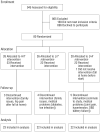Randomized clinical trial of 3 types of physical exercise for patients with Parkinson disease
- PMID: 23128427
- PMCID: PMC4574905
- DOI: 10.1001/jamaneurol.2013.646
Randomized clinical trial of 3 types of physical exercise for patients with Parkinson disease
Abstract
Objective: To compare the efficacy of treadmill exercises and stretching and resistance exercises in improving gait speed, strength, and fitness for patients with Parkinson disease.
Design: A comparative, prospective, randomized, single-blinded clinical trial of 3 types of physical exercise.
Setting: The Parkinson's Disease and Movement Disorders Center at the University of Maryland and the Baltimore Veterans Affairs Medical Center, Geriatric Research Education and Clinical Center.
Patients: A total of 67 patients with Parkinson disease who had gait impairment were randomly assigned to 1 of 3 arms of the trial. INTERVENTIONS; (1) A higher-intensity treadmill exercise (30 minutes at 70%-80% of heart rate reserve), (2) a lower-intensity treadmill exercise (50 minutes at 40%-50% of heart rate reserve), and (3) stretching and resistance exercises (2 sets of 10 repetitions on each leg on 3 resistance machines [leg press, leg extension, and curl]). These exercises were performed 3 times a week for 3 months.
Main outcome measures: The primary outcome measures were gait speed (6-minute walk), cardiovascular fitness (peak oxygen consumption per unit time [$$ VO2], and muscle strength (1-repetition maximum strength).
Results: All 3 types of physical exercise improved distance on the 6-minute walk: lower-intensity treadmill exercise (12% increase; P=.001), stretching and resistance exercises (9% increase; P<.02), and higher-intensity treadmill exercise (6% increase; P=.07), with no between-group differences. Both treadmill exercises improved peak $$ VO2 (7%-8% increase; P<.05) more than did the stretching and resistance exercises. Only stretching and resistance improved muscle strength (16% increase; P<.001).
Conclusions: The effects of exercise were seen across all 3 exercise groups. The lower-intensity treadmill exercise resulted in the greatest improvement in gait speed. Both the higher- and lower-intensity treadmill exercises improved cardiovascular fitness. Only the stretching and resistance exercises improved muscle strength. Therefore, exercise can improve gait speed, muscle strength, and fitness for patients with Parkinson disease. The combination of treadmill and resistance exercises may result in greater benefit and requires further investigation.
Figures

Comment in
-
The benefits of exercise in Parkinson disease.JAMA Neurol. 2013 Feb;70(2):156-7. doi: 10.1001/jamaneurol.2013.772. JAMA Neurol. 2013. PMID: 23117841 Free PMC article. No abstract available.
References
-
- Shulman LM, Gruber-Baldini AL, Anderson KE, et al. The evolution of disability in Parkinson disease. Mov Disord. 2008;23(6):790–796. - PubMed
-
- Goodwin VA, Richards SH, Taylor RS, Taylor AH, Campbell JL. The effectiveness of exercise interventions for people with Parkinson's disease: a systematic review and meta-analysis. Mov Disord. 2008;23(5):631–640. - PubMed
-
- Herman T, Giladi N, Hausdorff JM. Treadmill training for the treatment of gait disturbances in people with Parkinson's disease: a mini-review. J Neural Transm. 2009;116(3):307–318. - PubMed
-
- Mehrholz J, Friis R, Kugler J, Twork S, Storch A, Pohl M. Treadmill training for patients with Parkinson's disease. Cochrane Database Syst Rev. 2010;(1):CD007830. - PubMed
-
- Toth MJ, Fishman PS, Poehlman ET. Free-living daily energy expenditure in patients with Parkinson's disease. Neurology. 1997;48(1):88–91. - PubMed
Publication types
MeSH terms
Grants and funding
LinkOut - more resources
Full Text Sources
Other Literature Sources
Medical

